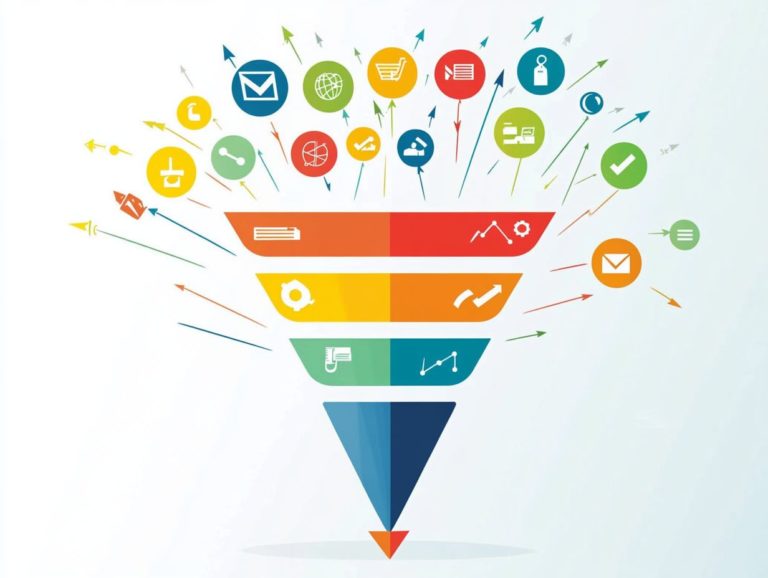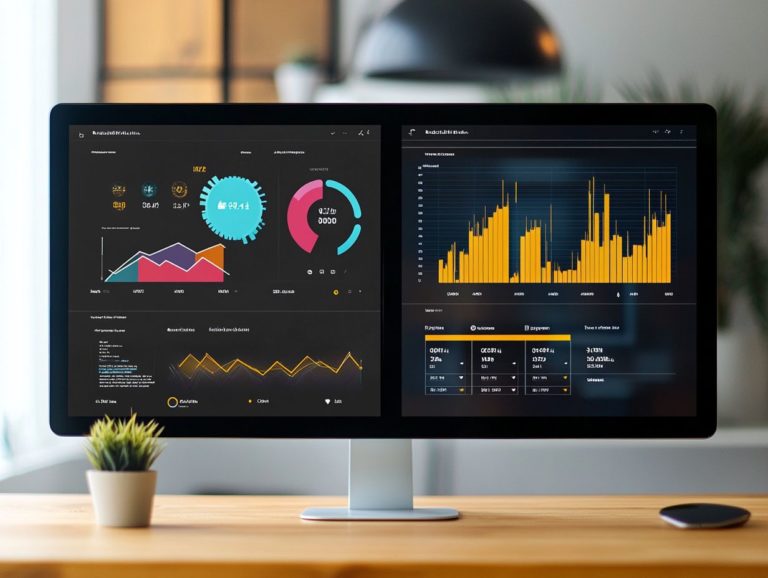5 Ways to Improve Call-to-Action Effectiveness
In today s digital landscape, a compelling call-to-action (CTA) is essential for capturing customer interest and driving conversions. Whether your goal is to boost sales, attract newsletter subscribers, or enhance engagement, the right CTA can truly make a world of difference.
Discover five powerful strategies that will transform your CTAs today! These strategies include employing persuasive language, instilling a sense of urgency, and optimizing your visuals. This article also addresses common pitfalls to sidestep, effective measurement techniques, and real-world examples that spark action.
Prepare to transform your CTAs into conversion powerhouses!
Contents
- Key Takeaways:
- 1. Use Strong and Clear Language
- 2. Create a Sense of Urgency
- 3. Make It Stand Out Visually
- 4. Test and Optimize Your CTA
- 5. Provide Incentives
- Why Is a Strong Call-to-Action Important?
- Frequently Asked Questions
- What is a call-to-action?
- Why is it important to improve call-to-action effectiveness?
- What are some ways to improve call-to-action effectiveness?
- How can A/B testing help improve call-to-action effectiveness?
- Can using multiple call-to-actions on one page be effective?
- Is it necessary to include a call-to-action in all marketing materials?
Key Takeaways:
- Use strong and clear language to grab attention and convey the desired action.
- Create a sense of urgency to encourage immediate action from the audience.
- Make the CTA stand out visually to catch the reader’s eye and make it easy to find.
1. Use Strong and Clear Language
Utilizing strong and clear language in your call-to-action (CTA) is essential for amplifying your marketing impact and boosting conversion rates. It directly shapes how potential customers engage with your landing page copy and overall marketing strategy.
This ensures they grasp what you offer and motivates them to take immediate action. For example, phrases like “Get Your Free Trial” or “Subscribe Now for Exclusive Offers” stand out as effective CTAs, succinctly outlining the benefits while encouraging engagement.
By tailoring your messaging to distinct audience segments, you can deepen your connection with recipients, making your message resonate even more. A well-crafted CTA not only drives clicks but also significantly enhances user experience, enabling potential customers to act with confidence rather than feeling confused or overwhelmed.
2. Create a Sense of Urgency
Creating urgency in your CTAs can significantly elevate engagement and conversions. By tapping into the fear of missing out (FOMO), which means the anxiety about missing an opportunity, you motivate potential customers to act quickly.
When you implement time-sensitive offers, you cultivate an environment where consumers feel compelled to take action. Using phrases like “Limited Time Offer” or “Only 3 Left in Stock!” captures attention and triggers a response fueled by the anxiety of missing an opportunity.
Retail giants frequently utilize countdown timers on product deals. They highlight dwindling time and stock to encourage impulse purchases. This strategy is all about seizing the moment and drives potential customers to make quicker decisions as they rush to secure their desired items before they’re gone.
3. Make It Stand Out Visually
To truly maximize the effectiveness of your CTAs, it s crucial to use a contrasting design that allows your clickable button to stand out on the landing page. This enhances user experience and drives engagement in your digital marketing efforts.
Consider employing colors that sharply contrast with the surrounding elements. For example, a bright orange button against a predominantly blue page acts as a beacon, irresistibly drawing users in.
Placement is equally important; by positioning the CTA above the fold, you ensure it remains visible without any scrolling required. This simple tactic not only boosts visibility but also encourages action, leading to higher conversion rates.
By applying these design principles, you can create dynamic landing pages that resonate with users, ultimately fostering a more engaging online experience.
4. Test and Optimize Your CTA

Regular A/B testing and optimization of your CTAs are vital for improving conversion rates. This process helps refine your strategy and aligns more closely with your customers’ preferences.
By experimenting with button colors, text, placement, and overall design, you can discover what resonates with your audience. Establishing clear key performance indicators or standard measures used to gauge success is essential to evaluate engagement and conversion rates.
Techniques like tracking click-through rates and conducting user surveys provide valuable insights. Adopting a culture of continuous improvement keeps your testing strategies dynamic, adapting to market trends and consumer behavior.
By following effective strategies, you can maintain a competitive edge in your optimization efforts, ensuring sustained growth and ongoing relevance.
5. Provide Incentives
Offering incentives like discounts, free trials, or exclusive content can supercharge your CTAs! These elements drive lead generation and make the value proposition clear, resonating with potential customers.
Incorporating these incentives captures attention and cultivates a sense of urgency that encourages immediate action. Transparently presenting pricing information influences decisions and often leads to better responses, especially when paired with positive emotional copywriting that highlights benefits.
This emotional appeal fosters a connection that nudges users toward taking action, effectively bridging the gap between interest and conversion.
Why Is a Strong Call-to-Action Important?
A strong call-to-action (CTA) is crucial for your marketing strategy as it directly influences conversion rates. It also shapes the overall message delivered to different audience segments.
CTAs guide potential customers through the sales funnel, which is the process that leads a customer from awareness to purchase. They act as signposts guiding individuals toward desired actions making a purchase, signing up for a newsletter, or downloading a resource.
For example, a brightly colored ‘Buy Now’ button can grab immediate attention and prompt quick decisions. Meanwhile, a ‘Learn More’ option nurtures leads needing extra information before committing.
Strategically placing CTAs across various platforms like social media, email campaigns, or landing pages can greatly enhance your marketing efforts. This customizes the user experience to meet their needs and behaviors.
What Are the Elements of a Successful CTA?
Successful CTAs are crafted with several essential elements. A clear value proposition grabs attention, while actionable language drives engagement think phrases like “Join Now” or “Get Your Free Trial” that prompt immediate action.
Emotional copywriting resonates with your target audience, ultimately leading to higher conversion rates.
These elements work together, creating a compelling invitation that addresses the needs of your audience. Highlighting how a subscription service saves time and money directly addresses their pain points.
Using emotional copy, such as “Imagine the peace of mind you’ll feel when…”, engages users personally, making your offer more relatable and enticing.
Together, these components capture attention and build trust, encouraging potential customers to take that crucial step toward conversion.
How Can A/B Testing Improve CTA Effectiveness?

A/B testing, or split testing, compares two versions of something to see which performs better. It’s an invaluable tool for enhancing the effectiveness of your CTAs. It enables you to experiment with various marketing messages, designs, and placements, helping you discover what truly resonates with your audience and elevates the user experience.
The journey begins with formulating clear hypotheses, speculating on how specific changes might influence user behavior. For example, you might theorize that a brighter button color could drive higher click-through rates.
Next, select appropriate measurements like conversion rates or engagement levels to accurately measure the impact of your tests. Once the tests are complete, analyzing the results isn’t just about identifying which variation performed better; it also involves diving into the reasons behind its success.
Consider successful case studies, such as a global e-commerce brand that boosted sales by 20% simply by altering its CTA button text. These examples underscore the power of meticulously executed A/B testing in optimizing user interactions and enhancing conversion rates.
What Are Some Common Mistakes to Avoid in CTAs?
Avoiding common mistakes in your CTAs is essential for getting the best results. Pitfalls like using ineffective language, overcomplicating your message, and neglecting user experience can significantly hinder your marketing campaigns and limit conversion rates.
When creating a strong call to action, focus on clarity and simplicity. If potential customers find the language too complex or the directive unclear, they’re less likely to engage. Many also overlook the importance of urgency, which can prompt immediate action. Use direct and actionable verbs like “Get,” “Join,” or “Discover,” making the reasons to act clear and compelling.
Testing different CTAs can reveal the phrasing and design that resonate best with your target audience. Regularly revisiting your CTAs as part of ongoing optimization can lead to improved performance and higher engagement rates.
How Can a Business Measure the Effectiveness of Their CTAs?
You can measure the effectiveness of your CTAs through various metrics, such as conversion rates and analytics data. This enables you to evaluate your marketing strategy and make informed decisions based on actual performance.
By utilizing tools like Google Analytics and heat map software, you gain deeper insights into user behavior and engagement levels. Analyzing click-through rates, bounce rates, and customer feedback helps you identify which calls to action truly resonate with your audience.
Understanding these metrics allows you to fine-tune your messaging and placement, ultimately enhancing the overall effectiveness of your campaigns. By applying this data-driven approach, you can adapt your strategies in real-time, leading to more impactful interactions and higher conversion rates in your future initiatives.
What Are Some Examples of Effective CTAs?
In the realm of digital marketing, effective CTAs are everywhere, exemplifying various strategies that seamlessly encourage user engagement and prompt action. These calls to action are crucial components of captivating marketing messages.
Picture bold buttons combined with catchy phrases; these CTAs act as gateways, inviting users to take essential steps, whether that involves signing up for a newsletter, requesting a demo, or making a purchase. Esteemed brands like HubSpot and Glossier have truly perfected this art, crafting CTAs that not only capture attention but also resonate deeply with their audiences.
By examining these successful examples, you can extract valuable insights into how language, design, and timing can significantly enhance user response. For more guidance, learn how to create compelling calls to action. Embracing these principles will enable you to refine your own CTAs, ensuring they are equally compelling and effective in capturing the interest of potential customers.
Frequently Asked Questions
Got questions? We’ve got answers!

What is a call-to-action?
A call-to-action is a statement or instruction that prompts the audience to take a specific action, such as joining a service, making a purchase, or subscribing to a newsletter.
Why is it important to improve call-to-action effectiveness?
A well-crafted call-to-action can significantly increase conversion rates. It drives desired actions from your audience, leading to higher sales and business success.
What are some ways to improve call-to-action effectiveness?
- Use action-oriented language: Your call-to-action should be clear, direct, and encourage immediate action.
- Create a sense of urgency: Creating urgency can motivate your audience to act quickly.
- Keep it short and simple: A concise call-to-action makes it easy for your audience to understand and take action.
- Use eye-catching design: Your call-to-action s design should stand out to grab attention.
- Test and optimize: Continuously testing your call-to-action helps determine what works best for your audience.
How can A/B testing help improve call-to-action effectiveness?
A/B testing, which means comparing two versions to see which one works better, involves creating two versions of a call-to-action and testing them against each other. This helps you find the most effective design, language, or placement for your audience.
Can using multiple call-to-actions on one page be effective?
Using multiple call-to-actions can be effective if they are strategically placed and serve different purposes. For instance, one call-to-action can encourage signing up for a newsletter, while another can prompt a purchase.
Is it necessary to include a call-to-action in all marketing materials?
Always include a call-to-action in your marketing materials! It drives your audience to take action. Without it, they may not know what to do next or feel motivated to act.






